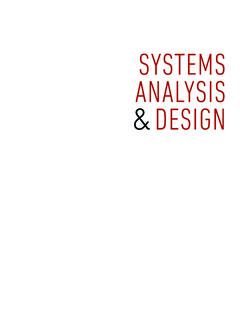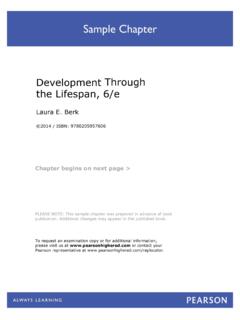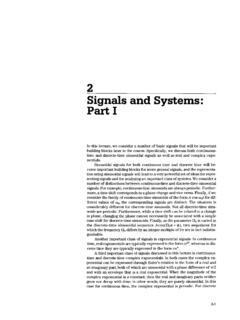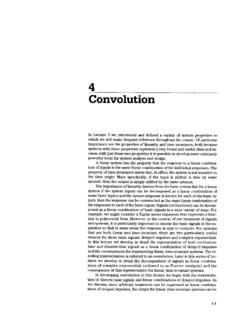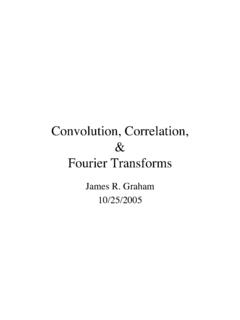Transcription of Discrete-Time FourierTransform - Pearson
1 CHAPTER7 discrete -TimeFourier TransformIn Chapter 3 and Appendix C, we showed that interesting continuous- time waveformsx(t)can be synthesized by summing sinusoids, or complex exponential signals, havingdifferent frequenciesfkand complex amplitudesak. We also introduced the conceptof thespectrumof a signal as the collection of information about the frequencies andcorresponding complex amplitudes{fk,ak}of the complex exponential signals, and foundit convenient to display the spectrum as a plot of spectrum lines versus frequency,each labeled with amplitude and phase.
2 This spectrum plot is afrequency-domainrepresentationthat tells us at a glance how much of each frequency is present in thesignal. In Chapter 4, we extended the spectrum concept from continuous- time signalsx(t)to Discrete-Time signalsx[n]obtained by samplingx(t). In the Discrete-Time case, theline spectrum is plotted as a function of normalized frequency . In Chapter 6, wedeveloped the frequency responseH(ej )which is the frequency-domain representationof an FIR filter. Since an FIR filter can also be characterized in the time domain by itsimpulse response signalh[n], it is not hard to imagine that the frequency response is thefrequency-domain representation,orspectrum, of the sequenceh[n].
3 236. @ @4&@$ QEG 'FC @ @4&@$ QEG 'FC DTFT: FOURIER TRANSFORM FOR Discrete-Time SIGNALS237In this chapter, we take the next step by developing thediscrete- time Fourier transform(DTFT). The DTFT is a frequency-domain representation for a wide range of both finite-and infinite-length Discrete-Time signalsx[n]. The DTFT is denoted asX(ej ), whichshows that the frequency dependence always includes the complex exponential functionej . The operation of taking the Fourier transform of a signal will become a commontool for analyzing signals and systemsin the frequency application of the DTFT is usually called Fourier analysis, or spectrum analysisor going into the Fourier domain or frequency domain.
4 Thus, the words spectrum,Fourier, and frequency-domain representation become equivalent, even though each oneretains its own distinct DTFT: Fourier Transform for Discrete-Time SignalsThe concept of frequency response discussed in Chapter 6 emerged from analysisshowing that if an input to an LTI Discrete-Time system is of the formx[n]=ej n,then the corresponding output has the formy[n]=H(ej )ej n, whereH(ej )is calledthe frequency response of the LTI system. This fact, coupled with the principle ofsuperposition for LTI systems leads to the fundamental result that the frequency responsefunctionH(ej )is sufficient to determine the output due to any linear combination ofsignals of the formej nor cos( n+ ).
5 For Discrete-Time filters such as the causalFIR filters discussed in Chapter 6, the frequency response function is obtained from thesummation formulaH(ej )=M n=0h[n]e j n=h[0]+h[1]e j + +h[M]e j M( )whereh[n]is the impulse response. In a mathematical sense, the impulse responseh[n]istransformedinto the frequency response by the operation of evaluating ( ) for eachvalue of over the domain < . The operation of transformation (adding up theterms in ( ) for each value ) replaces a function of a Discrete-Time indexn(a sequence)by a periodic function of the continuous frequency variable.
6 By this transformation,the time -domain representationh[n]is replaced by the frequency-domain representationH(ej ). For this notion to be complete and useful, we need to know that the result of thetransformation is unique, and we need the ability to go back from the frequency-domainrepresentation to the time -domain representation. That is, we need aninverse transformthat recovers the originalh[n]fromH(ej ). In Chapter 6, we showed that the sequencecan be reconstructed from a frequency response represented in terms of powers ofe j as in ( ) by simply picking off the coefficients of the polynomial since,h[n]is thecoefficient ofe j n.
7 While this process can be effective ifMis small, there is a muchmore powerful approach to inverting the transformation that holds even for is common in engineering to say that we take the Discrete-Time Fourier transform when we meanthat we considerX(ej )as our representation of a signalx[n].. @ @4&@$ QEG 'FC @ @4&@$ QEG 'FC 7 Discrete-Time FOURIER TRANSFORMIn this section, we show that the frequency response is identical to the result ofapplying the more general concept of the DTFT to the impulse response of the LTIsystem.
8 We give an integral form for the inverse DTFT that can be used even whenH(ej )does not have a finite polynomial representation such as ( ). Furthermore,we show that the DTFT can be used to represent a wide range of sequences, includingsequences of infinite length, and that these sequences can be impulse responses, inputsto LTI systems, outputs of LTI systems, or indeed, any sequence that satisfies certainconditions to be discussed in this Forward DTFTThe DTFT of a sequencex[n]is defined asDiscrete- time Fourier TransformX(ej )= n= x[n]e j n( )The DTFTX(ej )that results from the definition is a function of frequency.
9 Goingfrom the signalx[n]to its DTFT is referred to as taking the forward transform, andgoing from the DTFT back to the signal is referred to as taking the inverse transform. The limits on the sum in ( ) are shown as infinite so that the DTFT defined for infinitelylong signals as well as finite-length , a comparison of ( ) to ( )shows that if the sequence were a finite-length impulse response, then the DTFT of thatsequence would be the same as the frequency response of the FIR system. More generally,ifh[n]is the impulse response of an LTI system, then the DTFT ofh[n]is the frequencyresponseH(ej )of that system.
10 Examples of infinite-duration impulse response filterswill be given in Chapter that the DTFT functionX(ej )defined in ( ) is always periodic in withperiod 2 , that is,X(ej( +2 ))=X(ej ). DTFT of a Shifted Impulse SequenceOur first task is to develop examples of the DTFT for some common signals. The simplestcase is the time -shifted unit-impulse sequencex[n]= [n n0]. Its forward DTFT is bydefinitionX(ej )= n= [n n0]e j n2 The infinite limits are used to imply that the sum is over alln, wherex[n] =0.





